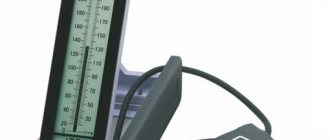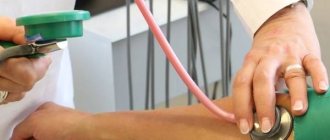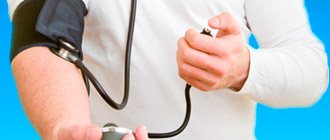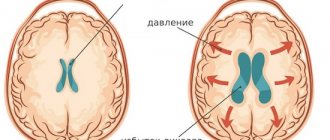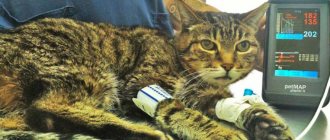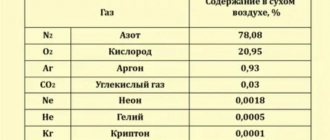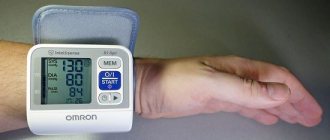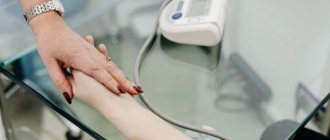Blood pressure depends on many factors, including age, and is slightly lower in children than in adults. But this does not mean that you should not pay attention to the child’s pressure. The topic is very important and, unfortunately, not all parents are interested in this. But in vain, because sometimes measuring a child’s blood pressure is vital. What do you need to know about childhood pressure and how to properly respond to its changes? Read below.
Source: Fotolia
A change in blood pressure does not always mean that something is wrong with the child - it can increase or decrease due to stress, weather changes, physical activity or lack of activity. You should not think that external changes only affect older people; children are also influenced by external factors. But you should consult a doctor if significant deviations from the norm are constant, and in addition, the child complains of a headache or simply feeling unwell. This condition of the child should definitely alert adults.
Source: Shutterstock
As a rule, blood pressure means blood pressure, and it is measured using special devices - tonometers. Tonometers are mechanical, when you need to hear the pulse, and electronic - pressure values are displayed on the monitor in the form of numbers. As a rule, these are 3 values - upper pressure, lower and pulse. Of course, mechanical tonometers are more accurate, but to measure blood pressure in children, it is still better to use electronic tonometers.
- Systolic pressure (upper) is the pressure of blood in the arteries at the moment the heart contracts. The ventricles of the heart contract and push blood into the vessels, creating pressure there. The level of systolic blood pressure depends mainly on the strength and speed of heart contraction and the condition of the myocardium.
- Diastolic (lower) pressure is the pressure that is maintained in the vessels at the moment the heart relaxes. This is pressure, which is influenced by the condition of the blood vessels, their elasticity and firmness, as well as the total volume of blood and the frequency of contractions of the heart muscle.
Source: pixabay.com
The difference between SBP and DBP is called pulse pressure and normally it should be about 30–40 units, but not more than 60% of systolic pressure. The units of blood pressure are millimeters of mercury (mmHg)
A little bit of theory
The method of measuring blood pressure in both adults and children is standard - a cuff of the required size is placed on the shoulder, and the head of a stethoscope is placed in the area of the cubital fossa (under the lower edge of the cuff).
| The head of the stethoscope is installed in the projection of the ulnar fossa. |
Having inflated the cuff to the required numbers, we begin a smooth deflation of air. The numbers on the pressure gauge corresponding to the appearance of rhythmic noise in the stethoscope mean systolic pressure (synonyms: upper, cardiac), the moment the noise disappears - diastolic pressure (synonyms: lower, venous).
In the case of using an automatic tonometer, the role of a stethoscope and a bulb for pumping air is performed by the device.
LIST OF ABBREVIATIONS
AH - arterial hypertension BP - blood pressure BP av - mean hemodynamic pressure DBP - diastopic blood pressure IV - time index PI - area index CV - coefficient of variation PBP - pulse arterial pressure SBP - systolic blood pressure SI - 24-hour ABPM index - 24-hour blood pressure monitoring pressure CO – standard deviation Av – average value HR – heart rate ECG – electrocardiogram.
The origins of hypertension in adults, according to many authors, are in childhood, but the nature and time of development of arterial hypertension in children are not well known. In addition, the proportion of children with low blood pressure has recently increased. In this regard, an urgent task in pediatrics is to improve the quality of early diagnosis of hyper- and hypotensive conditions.
In order to adequately assess blood pressure levels, it must be correctly measured and compared with standard values. N.S. Korotkov’s method, proposed in 1905 by our compatriot, has historically proven its clinical significance for diagnosing and predicting the course of arterial hypertension. However, accumulated experience shows that one-time measurements do not always reflect true blood pressure, do not take into account the “white coat hypertension” effect, and do not provide an idea of the circadian rhythm of blood pressure.
The possibility of continuous 24-hour recording of blood pressure in patients has long attracted doctors of various specialties. The invasive intra-arterial method (Oxford system through a catheter in the brachial artery), despite its high accuracy and continuity of measurement, is not widely used due to the high risk of complications.
Noninvasive intermittent but repeated blood pressure measurements using the Korotkoff auscultatory method, the oscillometric method, or a combination of both have been used for about 30 years.
The oscillometric method used in most blood pressure monitors has been known for a long time: one of the first devices for recording arterial oscillograms was designed by L.I. Uskov in 1904. However, widespread practical use of this method in medicine became possible in the 80s thanks to progress in computer technology. Numerous semi-automatic and automatic devices for one-time blood pressure measurements and monitors for daily blood pressure monitoring have appeared.
Self-measurement of blood pressure by patients has become widespread. Numerous studies have confirmed that blood pressure measured by nurses, the patient himself or an automatic device is lower than that measured by a doctor. Comparison of 24-hour blood pressure monitoring data with random measurements showed that about 40% of patients receive excessive antihypertensive treatment.
According to many authors, in approximately a third of adolescents with arterial hypertension identified during random blood pressure measurements, elevated blood pressure was also recorded during ABPM.
If in adults ABPM has been used for a long time and seriously for diagnosing hypertension and monitoring antihypertensive therapy, then in children this is a relatively new direction.
Features of children's tonometers
Of course, in everyday conditions the most convenient tonometer is an automatic one. BUT! Automatic blood pressure monitors are NOT SUITABLE FOR CHILDREN UNDER THREE YEARS OF AGE .
| Automatic blood pressure monitors are not used in children under 3 years of age! |
The reason for this age limit lies in the operating features of electronic tonometers. Having inflated the cuff, the “automatic” tonometer begins to deflate air from the cuff in small portions. And if for a standard cuff the volume of air deflated per step is proportional to 0.5 mm. column of mercury, then for a “baby” cuff the same volume will be equivalent to 5-10 mm. mercury column, and such an error in measurements is not acceptable. For children over three years of age, larger volume cuffs are used, allowing the device to correctly calculate the pressure release step and obtain accurate measurements.
In medicine, there are devices that can automatically measure blood pressure even in newborns. Cardiac monitors used in intensive care units have this function. These devices are minicomputers that allow you to measure not only blood pressure, but also respiratory rate, ECG, the amount of oxygen in the blood and many other indicators. However, cardiac monitors are bulky, expensive and require special technical training - they are not used in “home” practice.
| Criticare cardiac monitor with the function of measuring blood pressure for patients of all age groups. |
To measure blood pressure for children from 0 to three years old, only mechanical tonometers of a specialized “pediatric” configuration are used - the set includes cuffs of several sizes. As the child grows, the cuff is replaced with a larger one. With a mechanical tonometer, you can control the rate of air deflation from the cuff and accurately determine the beginning and end of noise in the stethoscope.
Suitable tonometers for measuring
It is not necessary to buy a separate blood pressure monitor for a child; it is enough to purchase a children’s cuff. When purchasing a tonometer, pay attention to its functionality. For a large family, it is worth choosing a tonometer with measurement memory for two users with recording of measurement time. This will help track the slightest deviations in pressure from the norm. For hypertensive patients, morning hypertension monitoring functions and a high blood pressure indicator will not be superfluous.
Tonometer Omron M1 Eco Approximate price: 1,700 rubles
- semi-automatic tonometer;
- memory for 42 results + date and time registration;
- indicators of arrhythmia and high blood pressure;
- calculation of the average blood pressure value from the last three results;
- large display.
Tonometer Omron M10-IT Approximate price: 8,900 rubles
- automatic tonometer;
- memory for 2 users for 84 measurements + guest mode;
- indicators of movement, arrhythmia, high blood pressure;
- the presence of a function for calculating the average blood pressure value from three measurements;
- It is possible to connect to a computer.
How to measure a child's blood pressure correctly
A few tips and rules.
| Choose the right cuff size! The blood pressure cuff should cover approximately 2/3 of the length of the upper arm. Therefore, cuffs of different sizes are used for children of different age groups. | ||||||||||
| Do you need a stethoscope to measure blood pressure? If you use a mechanical tonometer, yes, it is necessary. The most inexpensive one will do, but preferably a stethoscope with a flat head; during measurements it is convenient to slip it under the tonometer cuff. | ||||||||||
| To what numbers should I inflate the blood pressure cuff? To avoid causing unnecessary discomfort to the child, do not inflate the cuff too much - it is enough to inflate it by 20 mmHg. higher than expected figures. The table below shows normal values of systolic (SD) and diastolic (DD) pressure in children of different ages. | ||||||||||
| Age | up to 2 weeks | 2-4 weeks | up to 1 year | 2-3 years | 3-5 years | 6-9 years | 10-12 years | 13-25 years old | ||
| Blood pressure, mmHg | SD | min | 60 | 80 | 90 | 100 | 100 | 100 | 110 | 110 |
| max | 96 | 112 | 112 | 112 | 116 | 122 | 126 | 136 | ||
| DD | min | 40 | 40 | 50 | 60 | 60 | 60 | 70 | 70 | |
| max | 50 | 74 | 74 | 74 | 76 | 78 | 82 | 86 | ||
* BP is blood pressure, SD is systolic (“cardiac”) pressure, DD is diastolic (“venous”) pressure.
Is it possible to use an adult automatic wrist blood pressure monitor for children under 3 years of age? NO! Using a wrist tonometer to measure pressure on the shoulder is not an accurate method and is not used in professional medical practice. Will I be able to learn how to measure my child's blood pressure?Learning to measure blood pressure for a child, even a newborn, is not difficult, it is accessible to everyone! It just takes a little practice. If you have never used a tonometer, it is advisable that your actions be monitored by a medical professional at the initial stage. It is important that the child remains calm while measuring blood pressure. The procedure itself is painless, but does cause some discomfort. Children quickly get used to regular blood pressure measurement, and you will have the necessary experience to carry out the procedure quickly - blood pressure measurement will become a routine procedure that will not cause concern to either you or your baby. Where to buy a children's blood pressure monitor?Not all manufacturers of tonometers produce models designed specifically for children. Children's tonometers Rudolf Riester (Germany) are a rare case when the assortment includes not one, but several models.Blood pressure in children from 7 to 17 years old
| Age, years | In boys | For girls | ||
| systolic | diastolic | systolic | diastolic | |
| 7 | 94.5±9.2 | 53.6±8.3 | 93.4±8.7 | 53.1±8.5 |
| 8 | 96.1±9.1 | 55.2±8.6 | 94.8±10.0 | 54.6±8.4 |
| 9 | 97.0±9.3 | 59.1±7.8 | 98.9±9.8 | 56.2±8.1 |
| 10 | 98.8±9.6 | 60.3±8.3 | 101.3±9.5 | 58.9±8.5 |
| 11 | 99.4±8.4 | 60.9±8.2 | 102.6±9.3 | 60.0±8.7 |
| 12 | 102.8±10.1 | 61.3±8.5 | 105.2±10.8 | 62.4±8.9 |
| 13 | 105.7±11.2 | 62.4±8.7 | 108.0±10.6 | 64.9±9.0 |
| 14 | 111.1±10.8 | 64.8±8.6 | 110.6±9.9 | 67.1±7.4 |
| 15 | 112.4±11.4 | 66.7±7.9 | 111.1±9.7 | 67.9±8.1 |
| 16 | 113.5±8.9 | 70.2±8.8 | 111.3±9.1 | 68.3±8.4 |
| 17 | 114.1±10.2 | 71.4±8.6 | 112.1±10.0 | 69.2±8.7 |
Child blood indicators by age: tables
You can also determine the child’s normal blood pressure using the formula. This formula will especially help parents of babies under one year old. If you have a suspicion that the baby’s capriciousness is associated precisely with changes in blood pressure, then it is better to play it safe and still make sure that the baby’s blood pressure corresponds to the norm.
| Age | Systolic (upper) | Diastolic (lower) |
| Up to 1 year | Number of months × 2 + 76 | 1/2–2/3 of systolic |
| Over 12 months | Number of years × 2 + 90 | Number of years + 60 |
When calculating a child’s pressure using the formula, a deviation of up to 30 units is allowed in the direction of increase. So there is no need to sound the alarm prematurely. But consulting a pediatrician won’t hurt in any case.
Diseases of dirty hands: what are they and what parents need to know
Age indicators of RR and HR
| Age | BH/min | Heart rate beats/min |
| Newborn | 40-60 | 120-140 |
| 1-2 months | 35-48 | 130-135 |
| 6 months | 35 | 130 |
| 1 year | 30 | 120 |
| 5 years | 25 | 100 |
| 8 years | 90 | |
| 10 years | 20 | 80 |
| 14 years | 20 | 70 |
Correcting results when measuring with a tonometer for adults
As mentioned above, a large cuff lowers the pressure.
There is a technique with which you can adjust the indicators.
When measuring blood pressure with an adult tonometer, it is necessary to add 10 mmHg to the obtained figures when measuring on the arm and 5 mmHg when performing manipulations on the thigh.
It is important to remember that the above method is not reliable and produces large errors.
If your child needs to have their blood pressure measured, contact your doctor or trained health care provider who can recommend appropriate equipment.
Measuring a child's blood pressure with a mechanical tonometer
Here we will talk about Korotkoff tones, which you should focus on when measuring:
- tone 1. The appearance of a clear sound in the stethoscope, which correlates with systolic pressure;
- tone 2 . Follows the first one, but has no diagnostic value, this sound is quieter and softer;
- tone 3. The sound begins to gradually increase, is not clinically significant;
- tone 4. The sound becomes muffled and disappears. This is diastolic pressure.
When measuring blood pressure using the Korotkoff method (mechanical tonometer), errors may be observed if the cuff is incorrectly selected. So, if it is higher than expected, blood pressure turns out to be falsely low. If the cuff is narrow, the pressure will be too high.
Sound artifacts may be heard if the child moves or cries during measurement.
Symptoms of increased intracranial pressure in infants (from open sources)
Anxiety, vague moodiness, sleep disturbance, tearfulness and loudness. All children cry, but if a child constantly screams at the slightest irritation, sleeps poorly, is restless, then there is reason to think.
In addition, increased intracranial pressure can be assumed if the child eats poorly and little or eats small portions very often, spits up a lot and often, and perhaps periodically vomits.
Symptoms may also include increased muscle tone and tremors of the arms and legs when they tremble, for example, when excited or screaming.
There may be ophthalmological symptoms: constant or periodic strabismus, protrusion and drooping of the eyes and other changes.
Is it possible to make an accurate diagnosis by measuring ABI?
Determination of ABI helps to obtain an objective assessment of blood flow in the lower extremities, but does not reveal the exact location of vascular lesions and their extent. Measuring ABI does not replace diagnostic methods such as duplex scanning and angiography. Therefore, using only one ABI it is impossible to establish an accurate diagnosis of the disease. Despite the high information content of this research method, when planning surgical treatment, the patient may need to perform additional studies, such as duplex scanning, X-ray contrast angiography, computed tomography or magnetic resonance imaging of blood vessels.
Normal ABI values
Normally, the ankle-brachial index ranges between 0.9 and 1.3. An indicator above 1.3 is usually observed in patients suffering from diabetes mellitus and chronic renal failure: vessels in this condition are usually calcified and cannot be compressed. An ABI value below 0.9 indicates the presence of diseases of the arteries of the lower extremities, while ABI = 0.4 is considered critical. This suggests that the vitality of the limbs is at risk; in this condition, ulcers and gangrene can occur.
Indicators in people with atherosclerosis
An ABI below 0.9 may also indicate atherosclerosis of the vessels of the head and heart, which is an alarming prerequisite for a possible stroke or heart attack. The lower the ankle-brachial index, the greater the potential damage and the higher the risk of death from these diseases.
Blood pressure measurement. Memo.
Blood pressure (BP) is the pressure of blood in the major arteries of a person. There are two complementary indicators of blood pressure:
- upper (systolic) blood pressure is the level of blood pressure that occurs at the moments of maximum contraction of the heart muscle
- lower (diastolic) blood pressure is the level of blood pressure that occurs at moments of maximum relaxation of the heart muscle.
The unit of measurement for blood pressure is the millimeter of mercury (mmHg). Let's say the blood pressure level is 130/90, which means the following: the systolic pressure level is 130 mm Hg. Art., and diastolic – 90 mm Hg. Art.
A tonometer is used to measure blood pressure. Tonometers are mechanical and electronic.
To measure blood pressure using a mechanical tonometer, a phonendoscope is required.
Electronic tonometers are semi-automatic and automatic. In semi-automatic ones, air is pumped into the cuff manually, in automatic ones - with a compressor built into the pressure gauge.
Electronic tonometers determine not only blood pressure, but also heart rate (pulse).
Conditions for measuring blood pressure
- The measurement should be carried out in a comfortable, quiet environment, the room should be at room temperature.
- In this case, approximately 30-60 minutes before determining blood pressure, you should exclude smoking, drinking tonic drinks, alcohol, caffeine, as well as physical activity.
- Blood pressure can only be measured after the patient has rested for at least five minutes. If there was significant emotional or physical stress before the procedure, in order to achieve correct blood pressure readings, you need to increase the rest period to 15-30 minutes.
- Blood pressure should be measured in the morning and evening. When measuring blood pressure regularly, measurements should be taken at the same time 2 times a day, recorded and shown to the doctor at the next appointment. To increase accuracy, make a series of 3 measurements (this is especially important for patients with arrhythmia), the interval between measurements should be at least 2 minutes.
- The measurement should be taken while sitting (leaning on the back of a chair, with relaxed and uncrossed legs, the hand resting on the table, at heart level), in a calm environment, after a 5-minute rest. The legs should be straightened and on the floor, and the arms should be straightened and placed freely at heart level. It should be remembered that the shoulder should not be compressed by clothing, especially since it is incorrect to measure blood pressure through clothing. During the measurement you should not move or talk.
- During the initial measurement, blood pressure should be determined in both arms and subsequently measured blood pressure on the arm where the pressure was higher. (A blood pressure difference in the arms of up to 10-15 mm Hg is normal.)
- The bladder must be emptied before measuring blood pressure.
Measuring blood pressure with a manual tonometer (Korotkoff method)
- The tonometer cuff should be at the level of the heart (middle of the chest) 2 cm above the elbow. A finger should fit between the uninflated cuff and the arm. The cuff must cover at least 80% of the shoulder circumference and at least 40% of the length of the shoulder. It is possible (but not recommended) to place a cuff on a sleeve made of thin fabric, if this does not interfere with the measurement.
- Place the phonendoscope membrane on the pulsation point of the brachial artery (approximately in the area of the cubital fossa).
- Quickly inflate the cuff using a bulb (remember to close the bulb valve first to prevent air from escaping) to a pressure level of 20 mmHg. Art. exceeding systolic (determined by the disappearance of the pulse).
- Slowly deflate the cuff (using the valve) at a rate of 2 mmHg. Art. per second The first beat (sound, tone) heard corresponds to the value of systolic (upper) pressure. The level of cessation of sounds corresponds to diastolic (lower) pressure. If the tones are very weak, you should raise your hand, bend and straighten it several times and repeat the measurement.
- Normal blood pressure level: 110-139 / 60-89 mm Hg. Art. for adults
Rules for self-measurement of pressure with an electronic tonometer.
- Make yourself comfortable: free your hand from clothing and place it so that the cuff is level with your heart.
- Make sure that the rolled up sleeve does not squeeze your arm.
- Place the edge of the cuff 2-3 cm above the elbow joint, so that the cuff tube is on the midline of the inside of the arm.
- Apply the cuff snugly, but not tightly.
Rules for measuring blood pressure with a wrist device:
- Take off your watch and bracelet. Pay attention to the correct position of the wrist tonometer body relative to the palm. The correct position of the wrist tonometer body is recommended by photographs or drawings on the tonometer box or in the description of the tonometer.
- Place the cuff on your left wrist, positioning your hand so that your thumb is pointing up.
- Place the cuff directly on the skin, 1 - 1.5 cm above the wrist crease, wrap the cuff around your arm until it fits snugly.
- Bend your arm so that the device is positioned at the same level as your heart.
- During the measurement, relax and refrain from talking.
Errors when measuring pressure:
Mistake No. 1: Using inappropriate pressure measuring instruments.
Many people, for the sake of convenience, buy wrist tonometers - blood pressure monitors that are worn on the patient's wrist. A high-quality, branded wrist tonometer is a very good and convenient thing, but most wrist tonometers are intended exclusively for young patients, for people no older than 45 years. Wrist blood pressure monitors are not suitable for people over 45 years of age! And if a person, say 60 years old, uses a wrist tonometer, he will get completely incorrect results when measuring pressure. Many older people do not know this; they use wrist tonometers and rely on their readings. And blood pressure pills are also taken based on the readings of the wrist tonometer. And then they are surprised that taking the pills makes them feel bad.
Mistake No. 2. The habit of measuring blood pressure 2 or 3 times in a row.
Many people, especially those who use automatic tonometers, like to immediately measure the pressure a second time after the first pressure measurement “to be on the safe side.” It seems that, in their opinion, this will be more accurate. But it turns out the other way around - when measuring again, the pressure numbers may differ from the previous result by 20-30-40 units! This dispersion of numbers has led many people to consider automatic blood pressure monitors to be inaccurate. “What kind of device is this that gives different readings every time!” - dissatisfied buyers of such a device are indignant, having poorly studied the instructions for the electronic tonometer. Meanwhile, the instructions for most of these devices clearly indicate: repeated pressure measurements on the same arm can be carried out no earlier than 7-10 minutes after the previous measurement. Then everything will be fine with the device readings. If you really want to measure your blood pressure, then measure the blood pressure on your other arm a second time. But keep in mind that on the right and left hands the pressure numbers may differ by 10-15 units (10-15 mmHg). This is fine. In general, when used correctly, good electronic blood pressure monitors from trusted companies are very accurate and reliable. And their testimony can be trusted. They give fairly accurate readings. Unless the person taking the blood pressure makes the following mistake:
Mistake No. 3. The habit of measuring pressure in a hurry.
Most people measure their blood pressure almost on the run, casually. But it's not right. To get the correct numbers when measuring blood pressure, before this procedure you need to sit quietly for 5-10 minutes and relax. And further. Do not talk while measuring blood pressure! If, while measuring your blood pressure, you are talking, or worried, or taking your blood pressure right after going outside, the tonometer will show 20-30 extra units of pressure. Or even all 40. By the way, it is for this reason that many people whose blood pressure is basically normal turn out to be hypertensive when visiting doctors.
Imagine the scene: a patient comes to the clinic. Going to the doctor itself is a cause for concern for many people. And then there were a lot of people, a turbulent situation, a queue. For anyone, even a healthy person, the pressure in such a situation will jump by 10-20 units. But here, finally, is the coveted doctor’s office (after 30-40 minutes of waiting in line). The sight of a white coat causes stress in many people - “white coat syndrome”. We get an additional plus of 10-20 units to the pressure.
Measure your blood pressure correctly and be healthy!
What blood pressure is considered normal?
When working with children, it cannot be said that some blood pressure numbers are a universal norm. Doctors use special tables and graphs in which pressure is distributed by age and gender. These values are called percentiles.
Blood pressure is considered elevated if it is more than the 95th percentile, low if it is less than 5. This may seem like a rather complicated and incomprehensible approach; for ease and clarity, a table of normal indicators is presented.
Table 1. Girls:
| Age | 5th percentile | 50th percentile | 95th percentile |
| 1 year | 101/57 | 104/58 | 107/60 |
| 6 years | 108/71 | 111/73 | 114/60 |
| 12 years | 120/79 | 123/80 | 126/82 |
| 17 years | 126/83 | 129/84 | 132/86 |
Table 2. Boys:
| Age | 5th percentile | 50th percentile | 95th percentile |
| 1 year | 98/55 | 102/53 | 106/59 |
| 6 years | 109/72 | 114/74 | 117/76 |
| 12 years | 119/79 | 123/81 | 127/83 |
| 17 years | 132/85 | 136/87 | 140/89 |
A child whose blood pressure is above the 95th percentile should visit the pediatrician at least three times and have their blood pressure measured. If the numbers are persistently high, a diagnosis of arterial hypertension is made and therapy is selected.
Calculation of body weight (M) in children
| In children of the first year of life | Body M at birth + 800 g (for the 1st month) + 600 g for each subsequent month of life up to 6 months. and + 400 g for each subsequent month after 6 months. |
| In children older than one year | Body m of a 5 year old child = 19 kg Up to 5 years: M = 19 – 2 for each missing year 5-11 years: M= 19 + 3 for each year exceeding 5 years Over 11 years old: M= 3 ages in years |
ABPM VARIABILITY
Blood pressure is one of more than 300 physiological processes in the body that are subject to circadian rhythms. Registration of blood pressure, provided that pressure is measured at intervals of 15–30 minutes throughout the day, gives a fairly accurate idea of BP variability. To assess variability, the following are used:
1. Determination of the daily index.
2. Calculation of the standard deviation or coefficient of blood pressure variability.
The daily index (DI) shows the difference between the average daytime and nighttime blood pressure values as a percentage of the daily average value and is calculated by the formula:
SI = (Avg. ADdn. - Avg. BP night.) : Avg. BP days x 100%.
The average SI values obtained in our study during 24-hour blood pressure monitoring are presented in Table 5.
Table 5. Average daily index values in healthy adolescents (13–15 years old) based on ABPM results
| Options | Boys | Girls | ||||
| GARDEN | DBP | BP avg. | GARDEN | DBP | ADsr. | |
| SI (%) | 12,2 | 18,8 | 16,6 | 12,1 | 20,2 | 17,2 |
For most people, nighttime blood pressure decreases by 10–20% compared to daytime levels. Based on the daily index value, four groups of patients are distinguished:
“dippers” – SI 10 – 20%,
“non-dippers” – SI 0 – 10%,
“over-dippers” – SI > 20%,
“night-peakers” – SI < 0.
According to our data, in 85% of healthy children the SI for SBP and DBP exceeds 10% “dippers”. Normally, children “night-peakers” are not found, i.e. with nighttime blood pressure exceeding average daytime values.
The coefficient of variation (KB) is a calculated indicator and is determined by the formula:
kb = CO:Avg x 100
where KB is the coefficient of variation,
SD – standard deviation,
Av – average value of the parameter.
The KB values obtained in our study during 24-hour blood pressure monitoring are presented in Table 6.
Table 6. Standard values of the coefficient of variation in healthy adolescents
| Index | Day | Night | ||||
| GARDEN | DBP | HELL | GARDEN | DBP | HELL | |
| Girls | ||||||
| KB, % | 11.3 | 16,3 | 12,3 | 10,6 | 14,4 | 12,1 |
| Boys | ||||||
| KB, % | 11.2 | 14,5 | 12,1 | 11,2 | 14,7 | 12,7 |
In Fig. Figure 1 shows the daily profile of average hemodynamic blood pressure, constructed on the basis of a polynomial analysis of data obtained from daily blood pressure monitoring in adolescents of both sexes (6th degree polynomial). According to our data, healthy children have a minimum blood pressure of avg. at 2 am. Subsequently, blood pressure increases and reaches the first peak at 10–11 am, decreases moderately at 4 pm and the second peak is observed at 19–20 pm.
Rice. 1. Daily profile of mean hemodynamic blood pressure in healthy adolescents.
In modern conditions, early detection of changes in blood pressure levels in children is extremely important. Daily blood pressure monitoring allows you to verify initial deviations in the circadian rhythm and blood pressure. Currently, there are no normative ABPM data for children. This manual summarizes the first experience in conducting and analyzing ABPM in children. If ABPM parameters exceed the specified limits, it is not clearly pathological, but should be considered as a risk factor for the development of hypertension in adult life.
Like adults, children with arterial hypertension, as a rule, do not have any external manifestations and signs that clearly distinguish between essential and symptomatic hypertension. Further accumulation of experience in conducting 24-hour blood pressure monitoring in children with renal, endocrine pathologies, and essential hypertension will provide new criteria for the differential diagnosis of these diseases.
